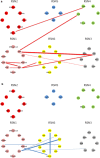Abnormal resting-state cerebral-limbic functional connectivity in bipolar depression and unipolar depression
- PMID: 31208340
- PMCID: PMC6580561
- DOI: 10.1186/s12868-019-0508-6
Abnormal resting-state cerebral-limbic functional connectivity in bipolar depression and unipolar depression
Abstract
Background: Distinctive patterns of functional connectivity (FC) abnormalities in neural circuitry has been reported in patients with bipolar depression (BD) and unipolar depression (UD). However, it is unclear that whether this distinct functional connectivity patterns are diagnosis specific between BD and UD. This study aimed to compare patterns of functional connectivity among BD, UD and healthy controls (HC) and determine the distinct functional connectivity patterns which can differentiate BD from UD.
Method: Totally 23 BD, 22 UD, and 24 HC were recruited to undergo resting-state fMRI scanning. FC between each pair of brain regions was calculated and compared among the three groups, the associations of FC with depressive symptom were also analyzed.
Results: Both patient groups showed significantly decreased cerebral-limbic FC located between the default mode network [posterior cingulated gyrus (PCG) and precuneus] and limbic regions (hippocampus, amygdala and thalamus) than HC. Moreover, the BD group exhibited more decreased FC mainly in the cortical regions (middle temporal gyrus, PCG, medial superior frontal gyrus, inferior occipital gyrus and superior temporal gyrus), but the UD group is more associated with limbic alterations. These decreased FCs were negatively correlated with HAMD scores in both BD and UD patients.
Conclusions: BD and UD patients demonstrate different patterns of abnormal cerebral-limbic FC, reflected by decreased FC within cerebral cortex and limbic regions in BD and UD, respectively. The distinct FC abnormal pattern of the cerebral-limbic circuit might be applied as biomarkers to differentiate these two depressive patient groups.
Keywords: Cerebral-limbic; Depression; Functional activity; Resting-state.
Conflict of interest statement
The authors declare that they have no competing interests.
Figures

Similar articles
-
Topologically convergent and divergent functional connectivity patterns in unmedicated unipolar depression and bipolar disorder.Transl Psychiatry. 2017 Jul 4;7(7):e1165. doi: 10.1038/tp.2017.117. Transl Psychiatry. 2017. PMID: 28675389 Free PMC article.
-
Altered effective connectivity model in the default mode network between bipolar and unipolar depression based on resting-state fMRI.J Affect Disord. 2015 Aug 15;182:8-17. doi: 10.1016/j.jad.2015.04.009. Epub 2015 Apr 11. J Affect Disord. 2015. PMID: 25942576
-
Interhemispheric resting state functional connectivity abnormalities in unipolar depression and bipolar depression.Bipolar Disord. 2015 Aug;17(5):486-95. doi: 10.1111/bdi.12315. Epub 2015 Jun 9. Bipolar Disord. 2015. PMID: 26241359
-
Differentiating between bipolar and unipolar depression in functional and structural MRI studies.Prog Neuropsychopharmacol Biol Psychiatry. 2019 Apr 20;91:20-27. doi: 10.1016/j.pnpbp.2018.03.022. Epub 2018 Mar 28. Prog Neuropsychopharmacol Biol Psychiatry. 2019. PMID: 29601896 Review.
-
Distinguishing between unipolar depression and bipolar depression: current and future clinical and neuroimaging perspectives.Biol Psychiatry. 2013 Jan 15;73(2):111-8. doi: 10.1016/j.biopsych.2012.06.010. Epub 2012 Jul 10. Biol Psychiatry. 2013. PMID: 22784485 Free PMC article. Review.
Cited by
-
Unearthing the hidden links: Investigating the functional connectivity between amygdala subregions and brain networks in bipolar disorder through resting-state fMRI.Heliyon. 2024 Sep 19;10(19):e38115. doi: 10.1016/j.heliyon.2024.e38115. eCollection 2024 Oct 15. Heliyon. 2024. PMID: 39498275 Free PMC article.
-
Causal mechanisms of quadruple networks in pediatric bipolar disorder.Psychol Med. 2024 Dec 16;54(16):1-12. doi: 10.1017/S0033291724002885. Online ahead of print. Psychol Med. 2024. PMID: 39679552 Free PMC article.
-
Altered functional activity in bipolar disorder: A comprehensive review from a large-scale network perspective.Brain Behav. 2021 Jan;11(1):e01953. doi: 10.1002/brb3.1953. Epub 2020 Nov 18. Brain Behav. 2021. PMID: 33210461 Free PMC article.
-
Emotion-Related Network Reorganization Following Fish Oil Supplementation in Depressed Bipolar Offspring: An fMRI Graph-Based Connectome Analysis.J Affect Disord. 2021 Sep 1;292:319-327. doi: 10.1016/j.jad.2021.05.086. Epub 2021 Jun 5. J Affect Disord. 2021. PMID: 34139404 Free PMC article. Clinical Trial.
-
Effects of 12-week escitalopram treatment on resting-state functional connectivity of large-scale brain networks in major depressive disorder.Hum Brain Mapp. 2023 Apr 15;44(6):2572-2584. doi: 10.1002/hbm.26231. Epub 2023 Feb 11. Hum Brain Mapp. 2023. PMID: 36773284 Free PMC article. Clinical Trial.
References
-
- Woo YS, Shim IH, Wang H-R, Song HR, Jun T-Y, Bahk W-M. A diagnosis of bipolar spectrum disorder predicts diagnostic conversion from unipolar depression to bipolar disorder: a 5-year retrospective study. J Affect Disord. 2014;174C:83–88. - PubMed
Publication types
MeSH terms
LinkOut - more resources
Full Text Sources
Medical

